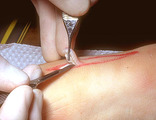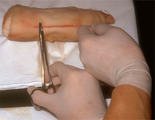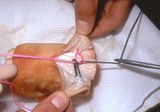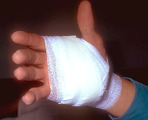The Health Education Assets Library (HEAL) is a collection of over 22,000 freely available digital materials for health sciences education. The collection is now housed at the University of Utah J. Willard Marriott Digital Library.
TO
Filters: Collection: "ehsl_heal"
| Title | Description | Subject | Collection | ||
|---|---|---|---|---|---|
| 926 |
 |
Scissors | The specimen can also be removed using scissors as one cuts beneath the dermis. | Knowledge Weavers Dermatology | |
| 927 |
 |
Suturing | This demonstrates the same maneuver using suture. | Knowledge Weavers Dermatology | |
| 928 |
 |
Basal cell carcinoma: excision removal | This demonstrates the wound one week after the surgery. The eversion will disappear within several weeks because of the downward and lateral pulling forces on the wound. | Surgical Methods | Knowledge Weavers Dermatology |
| 929 |
 |
Treating mild acne | This demonstrates two approaches to treating mild acne (comedos and less than about 10 red papules and pustules). The first treatment is shown on the left,and she applies Cleocin-T lotion to her face each morning, and Cleocin-T lotion and Retin-A 0.025% cream to her face each evening. A second alter... | Drug Effects | Knowledge Weavers Dermatology |
| 930 |
 |
Treatment of Scabies | Treatment of choice for scabies is to apply permethrin (Elimite) overnight from the neck down, and to ensure that everyone in the patient's family be treated at the same time. The bedding and clothing from the past week should be washed or dry cleaned, or it can be placed in a plastic bag and set as... | Knowledge Weavers Dermatology | |
| 931 |
 |
Stratum corneum | The thick stratum corneum of the palms and soles prevents chemicals from readily entering those areas. This patient worked around a chemical to which he became allergic, and you can see the line of demarcation along the sides of his hands indicating the thinner stratum corneum on the dorsum of the h... | Knowledge Weavers Dermatology | |
| 932 |
 |
Accutane | At the end of five months, virtually everyone clears, and only occasionally are six or seven months required. | Accutane | Knowledge Weavers Dermatology |
| 933 |
 |
Administration of epinephrine into the subcutaneous fat | This demonstrates administration of epinephrine into the subcutaneous fat. | Dosage | Knowledge Weavers Dermatology |
| 934 |
 |
Accutane | This is the patient shown at the end of Accutane therapy (usually five months), and most patients who have completed five months of Accutane, 1 mg/kg/day obtain long-term remissions of their acne. | Accutane | Knowledge Weavers Dermatology |
| 935 |
 |
Atopic dermatitis involving the axilla | Atopic dermatitis involving the axilla. Note that the axillary fold is spared, and there is a ring of redness and scaling around the axillary fold. | Knowledge Weavers Dermatology | |
| 936 |
 |
Angiosarcoma | This patient had angiosarcoma. | Knowledge Weavers Dermatology | |
| 937 |
 |
Excision: suturing | The suture is tightened by pulling the suture with the hands ending in natural position. The knot tying procedures previously shown are done twice more until the four throws have been placed. Suture is then cut just above the knot. Deep dermals are placed roughly every cm along the under-surface (ba... | Knowledge Weavers Dermatology | |
| 938 |
 |
Undermining | The edges of the wound should pull together easily; if not, undermining needs to be done. Undermining means cutting the fibrous septae that connect the skin to the underlying fascia, and generally this is accomplished by using the scalpel to cut the septi just beneath the dermis as shown here. Under... | Knowledge Weavers Dermatology | |
| 939 |
 |
Scalpel | A puncture should be made at both ends of the wound to ensure that the points of the ellipse are very sharp and pointed. The specimen can then be removed by cutting beneath the dermis with a scalpel as shown here. | Knowledge Weavers Dermatology | |
| 940 |
 |
Seborrheic keratoses | The appearance of seborrheic keratoses immediately following freezing. The lesions should be frozen (kept white, or have a thaw time of) 30 seconds. | Knowledge Weavers Dermatology | |
| 941 |
 |
Suturing | This demonstrates the same maneuver using suture as the second throw is tightened with the left hand crossing over the right hand. This must be done to ensure that a square knot is formed. | Knowledge Weavers Dermatology | |
| 942 |
 |
Suturing | This third throw is initiated by placing the needle holder on the inside of the long arm (needle bearing end) of the V that is created. | Knowledge Weavers Dermatology | |
| 943 |
 |
Dermatitis biopsy | This is a biopsy of dermatitis. The epidermis (upper purple strip) is being infiltrated by lymphocytes (small purple dots), and they are also infiltrating into the dermis (lower pink area). The consequence of this lymphocytic attack is disruption of the maturation of the skin (scaling), vasodilation... | Knowledge Weavers Dermatology | |
| 944 |
 |
Suturing | The suture must be rotated in a right-hand direction to ensure that it is tightened along the long axis of the wound until the edges of the wound are pulled together and evert. | Knowledge Weavers Dermatology | |
| 945 |
 |
Nitric oxide | I generally use 50% nitric-oxide and 50% oxygen when I administer it to a patient through a nasal mask. For most adults and children I use a total flow of about 4 to 6 liters per minute. A general rule of thumb is that a person needs 100 cc's of gas per kg per minute. | Knowledge Weavers Dermatology | |
| 946 |
 |
Papular acne | When the closed comedos rupture, they can induce inflammation seen as red papules and pustules. When these inflammatory lesions form, an antibacterial needs to be used. | Anti-bacterial Agents | Knowledge Weavers Dermatology |
| 947 |
 |
Suturing | The needle holder is placed in the center of this V, and one can then begin to tie the suture. | Knowledge Weavers Dermatology | |
| 948 |
 |
Purpura | Purpura. This patient had vomited very vigorously, and the increased pressure within the capillaries caused some of them to rupture and red blood cells extravasated into the surrounding skin. Because there are red blood cells outside the vessels, compression does not cause this to blanch. | Knowledge Weavers Dermatology | |
| 949 |
 |
Androgenetic alopecia | Androgenetic alopecia often manifests as thinning of scalp hair on the vertex. | Knowledge Weavers Dermatology | |
| 950 |
 |
Wound dressings | This demonstrates the bulk dressing on the wound. The dressing should be changed twice daily, and the wound irrigated with sterile saline in an attempt to further remove any debris, including necrotic tissue. | Knowledge Weavers Dermatology |
